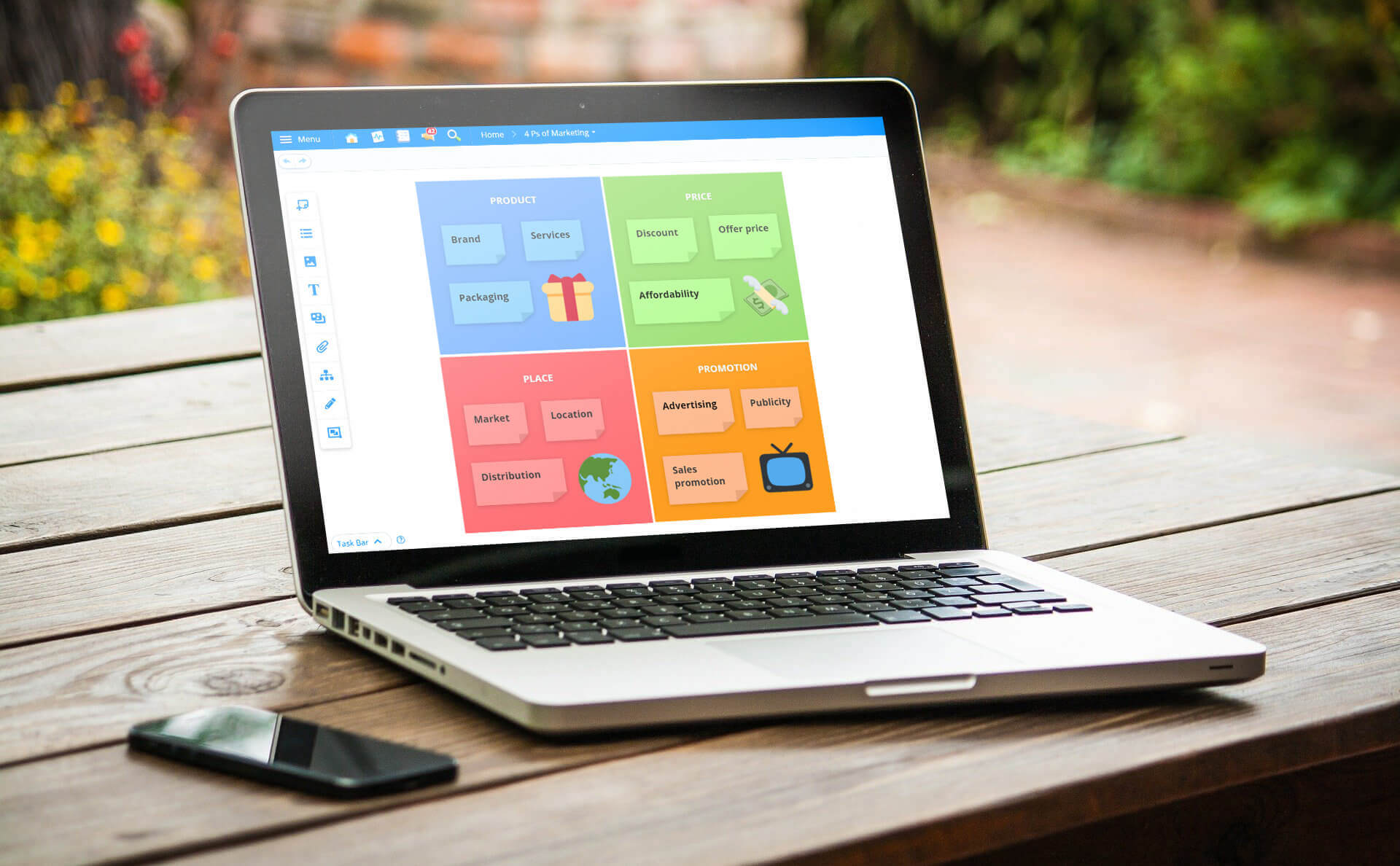As marketers well know, gaining a solid understanding of your customer base and how your product or service helps to solve their pain points is key to seeing success in your marketing efforts. So, how can you make sure your marketing strategy is setting you off on the right path?
We break down how you can use the 4 Ps of marketing model to help guide your strategy and ensure that your marketing efforts are both focused and effective.
A marketing strategy forms the foundation of your marketing efforts – it helps you to determine not only what your product or service is, but which audiences you will promote this to, and where you will reach them. With this in mind, it’s important to take time to really research and understand the market you’re going after and whether your product is solving a key pain point for your target audience.
If you’ve worked on a marketing strategy before, then you’ve probably heard of the ‘marketing mix’. This refers to the different choices an organization makes to bring their product or service to market. The 4 Ps concept is one model that marketers use to help define their marketing mix and understand how they can provide the right product to the right people, in the right place and at the right time.
What are the 4 Ps of marketing?
The 4 Ps of marketing is a model that considers the four key pillars of any marketing strategy. The 4 Ps of marketing stand for:
-
Product – The product you sell or the service you deliver.
-
Price – How much you charge for your product (or service).
-
Place – Where customers can find your product.
-
Promotion – How you promote your product.
The idea behind this model is to work through each of these pillars to define your marketing options, which will ultimately help you to enhance all the components of your marketing mix.
Below, we break down each of the 4 Ps of marketing in more detail and show how you can use this model to improve your marketing strategy.
Top tip: When considering each of the 4 Ps of marketing, be sure to keep your target audience in mind at all times. It may seem obvious, but if you’re unsure of who exactly you are designing your product and services for, it can be difficult to understand their specific pain points and where they will be most receptive to your marketing efforts.
Product
Product refers to all the things you offer to your customers. This could be physical merchandise, computer software or even training and consultation services. Once you know what you’re offering, the most important step is to determine what makes your product unique. How do you stand apart from your competitors? What are you offering that no one else is?
At this stage, it’s useful to conduct some competitor research to see what other similar products are available on the market and what their approach is. This will help you to identify what makes you stand out from the crowd, which you can then use to power your marketing efforts.
Begin by breaking down all the elements of your product or service. Consider what your product looks like, how it is branded, if there’s any specific tone of voice you use, and so on. Be sure to also identify your key features and services – and if there are any that are missing, or even any that could be removed altogether.
Capturing every element of what your product is, how you present it and how your audience uses it will give you a good foundation to ensure that your product is the best it can be and that it is meeting the needs of your customers before you dive deeper into your promotional activity.
Price
Price refers to how much you charge your customers for your product or service. Price plays an important factor in attracting your ideal customer, so when making decisions about pricing, consider how you want to be perceived. Are you an exclusive luxury brand, or do you want to appear more accessible? Keep in mind your ideal target customer and consider the lifestyle that they lead – would your product be something that aligns with their lifestyle and is it affordable for them?
Take some time to evaluate what the lowest price you would be willing to sell your product for is, and what the highest amount your consumers would be willing to pay. Would you consider offering discounts, or package bundles? It’s also useful to consider what your competitors are offering and for what price – perhaps you can provide more features or services for a cheaper price. Angles such as this can be crucial in swaying the minds of your customers.
Place
Place refers to the location of your product. For example, do you have physical stores, and if so, where? What do they look like, for example, are they boutique stores? Perhaps you provide training sessions across the globe – if so, which countries or cities do you travel to?
Place also refers to where your customers will see and access your product. For example, are your customers looking for you online, and if so, which platforms are they using to find you? Are they using social media or industry-specific forums? If you offer in-person services, where are you meeting your customers – are they at personal sessions, or perhaps at trade fairs?
At this stage, it’s useful to consider how your current distribution channels are working for you. If you sell your product or services across multiple countries, are there specific locations where demand is particularly strong? Collating this information means you can be more specific when considering the right location for your product.
Promotion
Promotion is the final pillar of the 4 Ps. Once you’ve delved into the previous 3 Ps of marketing, this is now where you determine how you will promote your product.
This is often the fun part as there are so many different channels you can use as marketers to get your product out to your audience! However, often it can be tricky to know which ones are going to work best for you. That’s where working through this model will help you to understand where your customers are actually ‘hanging out’ and where best you can capture their attention. If your audience is online, perhaps you may consider online advertising opportunities, email marketing or social media. Alternatively, you could consider TV or radio advertising, billboards or even press articles.
Another important element to consider is when you are going to promote your product or service offering. Are there certain times in the day where your audience is most active? Does your product tend to perform or sell well during a particular season of the year, or are there annual conferences that typically drive sales for you?
Conducting in-depth customer research into your target audience will significantly help you decide which distribution channels are going to be the most effective for your marketing efforts. If you know that your audience is active on social media, for example, but not email, focus your attention on those channels rather than attempting to utilize every marketing channel in a bid for results. Instead, understand where your audience is based, and focus your attention there.
How Ayoa can help with the 4 Ps of marketing
Now that we’ve broken down the 4 Ps of marketing, it’s clear that this exercise requires a lot of research and data gathering, with a touch of creative thinking for good measure.
This can be a fun and insightful exercise to carry out with your team – and Ayoa is an intuitive and collaborative tool that can not only help you capture your ideas and research but actually generate tasks off the back of it that you can action immediately.
Ayoa’s mind maps are a great way to generate ideas for each of the 4 Ps of marketing. By taking your central idea (‘Place’, for example) you can then add all of your ideas relating to this as interconnecting branches. The branches of a mind map replicate the way your brain naturally thinks, with one idea connecting to another until you have a web of ideas captured in once place.
You can also try using Ayoa’s whiteboards to brainstorm ideas and capture any relevant research. Digital whiteboards in Ayoa host a range of engaging and useful features, such as sticky notes, lists, images, sections to organize information, flowcharts and more. You can also add attachments such as Word documents, PDFs and weblinks, to ensure you have one place to store all of your research. Whiteboards can also be used to create a visual mood board to help you visualize your marketing strategy and get your creative juices flowing. This is a great way to visually capture the essence of what your product is and who your target audiences are.
Once you have your ideas and research captured, you can then use task boards in Ayoa to action your marketing strategy, assign tasks to colleagues and ensure your whole team is kept in the loop. Each task in Ayoa contains a bunch of handy features to keep you on track, such as due dates, progress indicators, notes, checklists and more.
Collaboration is at the core of Ayoa – so whether you’re using mind maps, whiteboards or task boards, you can work easily as a team, no matter where you’re based.
Top tip: Working remotely? Use our built-in Ayoa video and Zoom integration to chat with your team directly alongside your Ayoa boards, so you can discuss and capture ideas in real-time – just like you would in the office!
Ready to use the 4 Ps of marketing model to help guide your marketing strategy? Ayoa is here to help you generate fresh ideas and collate your research collaboratively with your team – then turn these directly into actionable tasks that you can track and manage as a team. Get started for FREE today!


